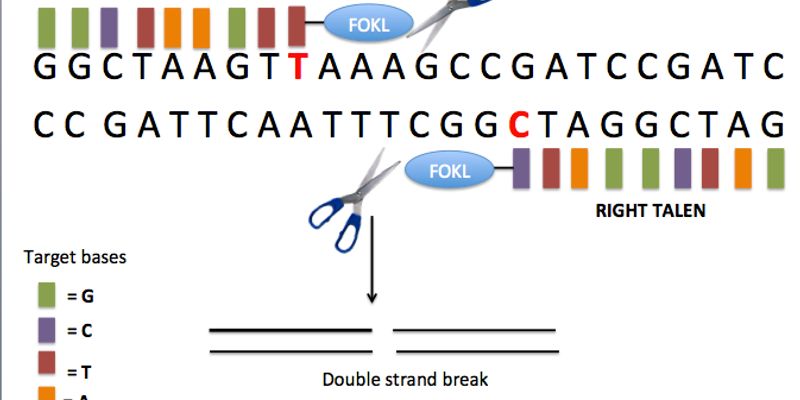Genome Editing
Genome editing: a group of technologies that give scientists the ability to alter an organism's DNA. Several approaches to genome editing have been developed.
-
The Cas9 endonuclease from the microbial adaptive immune system CRISPR can be easily programmed to bind or cleave specific DNA sequence using a short RNA guide. Cas9 is enabling the generatio...
AUG 20, 2014 | 11:30 AM
High-throughput short-read DNA sequencing has revolutionized our ability to measure genetic variation in the form of single-nucleotide polymorphisms (SNPs) in human genomes. However, ~75% of...
Pharmcogenomics (PGx) is the 2nd potential clinical application of genomic medicine, preceded by genomic application for cancer. In the recently published, 2012 Institute of Medicine report o...
Speaker:
Steven Wong, PhD, DABCC(TC), FACB
FEB 06, 2014 | 3:00 PM
C.E. CREDITS
Informatics and internet are widely accepted tools in education and research. In the past decades new teaching and learning strategies have been developed and implemented. E-learning was def...
FEB 06, 2014 | 7:00 AM
C.E. CREDITS
The question of pain in fish has been subject to much debate and, since fish are a popular experimental model globally and commercially important in fisheries, recreational angling and aquac...
FEB 05, 2014 | 2:00 PM
C.E. CREDITS
It is increasingly recognized that the genetic background (i.e., all genomic sequences other than the gene(s) of interest) can have profound influences on the phenotype of an animal model. I...
Speaker:
Fernando Benavides, DVM, PhD, DACLAM
Presented at: Laboratory Animal Sciences Virtual Event Series 2014
OCT 17, 2013 | 12:00 PM
The discovery of proteinaceous disease biomarkers and their clinical validation is critically important for the enablement of molecular diagnostics and ultimately, precision medicine. In spit...
Speaker:
Martin Latterich, PhD
OCT 17, 2013 | 11:00 AM
C.E. CREDITS
Curative therapy for metastatic disease in solid malignancies remains frustratingly elusive due to the long recognized problem of tumor cell heterogeneity and emergence of treatment resistant...
Speaker:
George Poste, DVM, DSc, PhD
AUG 22, 2013 | 4:00 PM
C.E. CREDITS
The next generation sequencing technologies are profoundly influencing our way to study biology. We have previously developed cap-analysis gene expression (CAGE) to simultaneously mRNA/noncod...
AUG 21, 2013 | 4:00 PM
C.E. CREDITS
High throughput transcriptomic analyses have shown that most of the human genome is dynamically transcribed to produce an extraordinary range of overlapping and interlacing intronic, intergen...
Speaker:
John Mattick, PhD,AO, FAA, FRCPA
Presented at: Genetics and Genomics Virtual Event Series 2013
AUG 21, 2013 | 10:00 AM
C.E. CREDITS
Medical applications of genetics and genomics have been advancing dramatically since completion of the sequencing of the human genome. The cost of DNA sequencing has plummeted, leading to the...
Our ability to view and alter biology is progressing at an exponential pace -- faster even than electronics. Next generation sequencing can be used to assess inherited, environmental and epi-...
The Project (PersonalGenomes.org) enables open observation and critique of a large cohort "test-driving" comprehensive participatory personalized medicine. This is the only fully open-access...
The Cas9 endonuclease from the microbial adaptive immune system CRISPR can be easily programmed to bind or cleave specific DNA sequence using a short RNA guide. Cas9 is enabling the generatio...
AUG 20, 2014 | 11:30 AM
High-throughput short-read DNA sequencing has revolutionized our ability to measure genetic variation in the form of single-nucleotide polymorphisms (SNPs) in human genomes. However, ~75% of...
Pharmcogenomics (PGx) is the 2nd potential clinical application of genomic medicine, preceded by genomic application for cancer. In the recently published, 2012 Institute of Medicine report o...
Speaker:
Steven Wong, PhD, DABCC(TC), FACB
FEB 06, 2014 | 3:00 PM
C.E. CREDITS
Informatics and internet are widely accepted tools in education and research. In the past decades new teaching and learning strategies have been developed and implemented. E-learning was def...
FEB 06, 2014 | 7:00 AM
C.E. CREDITS
The question of pain in fish has been subject to much debate and, since fish are a popular experimental model globally and commercially important in fisheries, recreational angling and aquac...
FEB 05, 2014 | 2:00 PM
C.E. CREDITS
It is increasingly recognized that the genetic background (i.e., all genomic sequences other than the gene(s) of interest) can have profound influences on the phenotype of an animal model. I...
Speaker:
Fernando Benavides, DVM, PhD, DACLAM
Presented at: Laboratory Animal Sciences Virtual Event Series 2014
OCT 17, 2013 | 12:00 PM
The discovery of proteinaceous disease biomarkers and their clinical validation is critically important for the enablement of molecular diagnostics and ultimately, precision medicine. In spit...
Speaker:
Martin Latterich, PhD
OCT 17, 2013 | 11:00 AM
C.E. CREDITS
Curative therapy for metastatic disease in solid malignancies remains frustratingly elusive due to the long recognized problem of tumor cell heterogeneity and emergence of treatment resistant...
Speaker:
George Poste, DVM, DSc, PhD
AUG 22, 2013 | 4:00 PM
C.E. CREDITS
The next generation sequencing technologies are profoundly influencing our way to study biology. We have previously developed cap-analysis gene expression (CAGE) to simultaneously mRNA/noncod...
AUG 21, 2013 | 4:00 PM
C.E. CREDITS
High throughput transcriptomic analyses have shown that most of the human genome is dynamically transcribed to produce an extraordinary range of overlapping and interlacing intronic, intergen...
Speaker:
John Mattick, PhD,AO, FAA, FRCPA
Presented at: Genetics and Genomics Virtual Event Series 2013
AUG 21, 2013 | 10:00 AM
C.E. CREDITS
Medical applications of genetics and genomics have been advancing dramatically since completion of the sequencing of the human genome. The cost of DNA sequencing has plummeted, leading to the...
Our ability to view and alter biology is progressing at an exponential pace -- faster even than electronics. Next generation sequencing can be used to assess inherited, environmental and epi-...
The Project (PersonalGenomes.org) enables open observation and critique of a large cohort "test-driving" comprehensive participatory personalized medicine. This is the only fully open-access...












